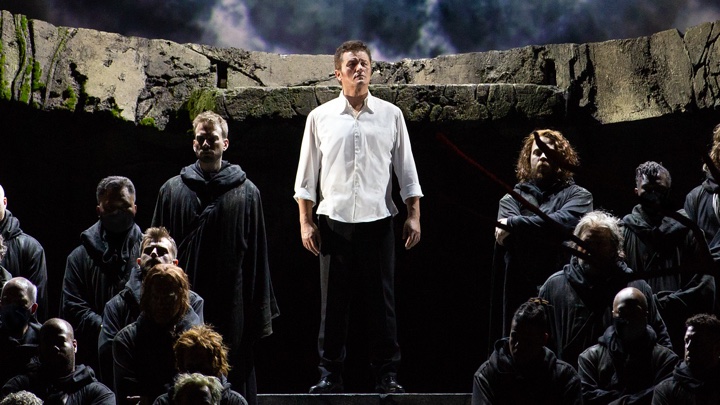

Much ink has been spilled already about this staging—including in these pages by Callum John Blackmore and Harry Rose—and I have little to add in the way of fresh insight. The scenic design by Tim Yip resembles a cross between storybook land and science fiction, and at times it feels more austere and distancing than the famously avant-garde “lightbox” production by Robert Wilson that it replaced. Director François Girard favors a static presentational style that has the focus on each scene planted at the center of the stage, flanked by adversaries who do little more than drag their long sleeves back and forth.
Aesthetically, each act resembles what a viewer might expect from a different opera. The ever-present faces of the moon in Act 1 brought Norma to mind, while the desiccated forest of Act 2 looked like a rejected sketch from the Mary Zimmerman production of Rusalka. And the less said about the gaping hole that protrudes above the stage, the better. Shot through with Peter Flaherty’s swirling, multicolored projections, it often reminded me of a festering bed sore.
With its mystical themes, unnamed heroes and suggestions of mortality play beneath the surface, Lohengrin requires elucidation. This is especially true in the United States, where it is revived with far less frequency than most other standard-rep operas by Wagner. Girard’s production fails to engage the novice viewer, and even leaves the expert scratching his head. In pure production terms, it’s more cooked goose than mighty swan.
The task then falls to the performers and the orchestra to fully communicate the work’s themes and messages. Thankfully, the assembled parties more than rise to the task. In his first major German assignment at the Met, Beczala never sacrifices unflagging lyricism for vocal heft. He creates a mystical Lohengrin who stands a world apart from the tortured humans who can’t seem to get out of their own way.
His delivery of “Im fernam land” was spellbinding, and his final sacrifice to save the kingdom of Antwerp was moving despite Girard’s clumsy distancing effects. It is a performance than truly deserves to be called one for the ages, and I’d have to reach back to Eric Owens as Alberich in the first run of the LePage Ring to find more effective Wagner acting at the Met.
Stikhina has shown herself a stage animal as Salome and Tosca, but here, she projected Elsa’s purity and constancy through becalmed stillness. Even saddled with a shapeless schmatte and Galadriel wig, she cut an arresting figure onstage, and her prayerful “Einsam in trüben Tragen” was sung with ravishing control. Stikhina controlled the dynamics of her naturally large voice masterfully and offered passages of gorgeous pianissimo singing.
The relative placidity of Stikhina’s characterization in Acts 1 and 2 gave way to white-hot abandon when, succumbing to the anxiety of influence around her, Elsa demands the one thing Lohengrin forbids: for her to know his name. It was a portrait of a woman driven to frenzy by society, and the way in which Stikhina immediately pulled back and realized her error was chilling. Her plaintive verbalization of Elsa’s regret—“Allewiger, erbarm dich mein”—will stay with me.
One cannot fault Goerke for her commitment to the bit. She throws herself into presenting a Hot Topic Ortrud, complete with magenta-streaked hair and lacy corset, waving her arms over an imaginary cauldron as she summons the spirit of the gods to aid in her revenge. Vocally, she sang with more luster and security than I’ve heard from her in a while—certainly more than as Madame Lidoine back in January—although there is noticeable separation now between registers.
Had Hall been given the luxury of rehearsal and not had to essentially create his character onstage, he likely could have crafted a compelling Telramund to match his well-sung performance. Still, he deserves credit for saving the day throughout the production’s run. Brian Mulligan was a resplendent Herald, Gunther Groissböck a movingly troubled King Heinrich—and their work here was all the more impressive having just sung Faninal and Ochs the night before. Talk about Yeoman’s service!
Furrer brought a sense of transparency and suspension to the score that complemented the lyrical singing from Beczala and Stikhina without sacrificing forward momentum. Perhaps owing to greater rehearsal time, the orchestra sounded more polished and secure than they had in Rosenkavalier the night before, and Donald Palumbo’s chorus was in its glory. Musically all around, this was Wagner done at a very high level.
As of this writing, Furrer and this cast will reunite for one final performance on April 1. Although the production cannot be endorsed from a dramaturgical standpoint, it should be unmissable for Wagner lovers in New York, who know that a great Lohengrin doesn’t come along every day.
Photo: Marty Sohl / Met Opera

























Comments